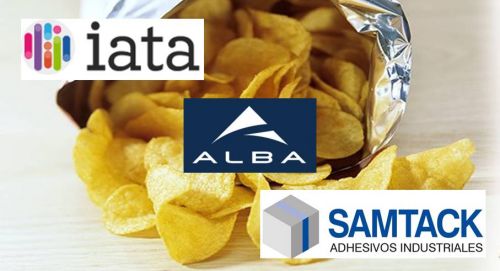
02/11/2018
Food packaging? ALBA!
Food packaging? ALBA!
Two recent experiments carried out at the ALBA synchrotron once again remind us how ALBA can be useful for developing new products, in this case in the food packaging sector.
On one hand, researchers from the Food Safety and Preservation department of the Institute of Agrochemistry and Food Technology (IATA-CSIC) are looking for more sustainable ways of producing food packaging with appropriate mechanical and chemical properties. They are investigating biopolymers that can be made from biomass such as algae.
They have analysed how adding different microalgae species can modify the properties of starch-based biopolymers. During the process, they have been performing SAXS/WAXS experiments at the refurbished NCD-SWEET beamline of the ALBA Synchrotron, devoted to non-crystalline diffraction. Results show that Spirulina microalgae is a promising alternative for replacing part of the corn starch matrix of biopolymers.
Furthermore, Samtack is a manufacturer of glues and adhesives specialized in the sector of graphic arts and packaging. Samtack has developed a new flexible multilayer system, in collaboration with the University of Zaragoza and the Complutense University of Madrid, that contains Selenium nanoparticles and is capable to increase food shelf life by absorbing free radicals.
The samples studied at ALBA consisted of different preparations of Selenium nanoparticles plastics laminates and solutions to check the amount of elemental selenium and other selenium oxidation states in each sample. The results obtained provided to Samtack very valuable information to improve the synthesis of the new flexible multilayer system.
It should be noted that Samtack used ALBA thanks to the CALIPSOplus European project that helps SMEs access European light sources. In this regard, a CALIPSOplus call is open until December 21 to request financing support.
Learn more about these two experiments: here and here
On one hand, researchers from the Food Safety and Preservation department of the Institute of Agrochemistry and Food Technology (IATA-CSIC) are looking for more sustainable ways of producing food packaging with appropriate mechanical and chemical properties. They are investigating biopolymers that can be made from biomass such as algae.
They have analysed how adding different microalgae species can modify the properties of starch-based biopolymers. During the process, they have been performing SAXS/WAXS experiments at the refurbished NCD-SWEET beamline of the ALBA Synchrotron, devoted to non-crystalline diffraction. Results show that Spirulina microalgae is a promising alternative for replacing part of the corn starch matrix of biopolymers.
Furthermore, Samtack is a manufacturer of glues and adhesives specialized in the sector of graphic arts and packaging. Samtack has developed a new flexible multilayer system, in collaboration with the University of Zaragoza and the Complutense University of Madrid, that contains Selenium nanoparticles and is capable to increase food shelf life by absorbing free radicals.
The samples studied at ALBA consisted of different preparations of Selenium nanoparticles plastics laminates and solutions to check the amount of elemental selenium and other selenium oxidation states in each sample. The results obtained provided to Samtack very valuable information to improve the synthesis of the new flexible multilayer system.
It should be noted that Samtack used ALBA thanks to the CALIPSOplus European project that helps SMEs access European light sources. In this regard, a CALIPSOplus call is open until December 21 to request financing support.
Learn more about these two experiments: here and here
More news
27/06/2017
Barcelona Synchrotron Park’s sustainable brownfield restoration program presented at AquaConSoil 2017
21/06/2017
Catalonia confirms itself as pole of attraction for foreign investments
15/06/2017
Construction of the Natura Bissé’s new world headquarters is well on its way
06/06/2017
Walk in the Park: the biodiversity routes await you
31/05/2017
UAB second most innovative university in Spain
24/05/2017
PRUAB: 10 years in strengthening relationships between research and business fabric









